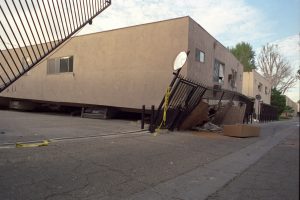The City of West Hollywood is hosting two meetings this month to inform residents and property owners about rent increases that may be associated with seismic retrofitting of rent-stabilized apartment buildings.
Two meetings will take place, with each covering the same information. The first meeting will be held this coming Saturday from 11 a.m. to 1 p.m. at the West Hollywood Park Auditorium, 647 N. San Vicente Blvd., south of Santa Monica. The second meeting will take place on Tuesday of next week from 6:30 to 8:30 p.m. at Plummer Park’s Fiesta Hall, 7377 Santa Monica Blvd..
The City Council agreed in April to require so-called “seismic-retrofitting” for wood-frame buildings with soft or open front walls such as those with first floor “tucked in” parking areas. It asked city staffers then to return with more information on a proposal to require strengthening of non-ductile concrete and steel frame buildings, which typically is the structure of multi-story residential buildings. “Non-ductile” refers to brittle concrete that isn’t reinforce

Last year the City Council formally adopted an ordinance establishing a framework for the seismic retrofitting of certain types of existing buildings. The city’s Building and Safety Division worked with structural engineering consultants to survey the city’s existing building stock and catalogued every building in West Hollywood. It determined that 780 buildings were “soft story” structures vulnerable to earthquake damage.
The city’s ordinance for the mandatory seismic retrofitting for soft-story residential and commercial buildings will become effective April 1. Owners of the apartment buildings will have until 2023 to retrofit them to protect them from earthquake damage. Such retrofits could require steel frames for a total cost of about $160,000 per building. Owners of these properties will be required to have an engineer assess their properties and complete any seismic retrofitting work within five years of receiving notice from the city.
Currently, a landlord may apply to increase tenants’ rents if total operating costs for the building exceed rent revenue. The city is reviewing the application process, and the two community meetings will provide an opportunity for property owners, managers, tenants and community members to provide input on possible revisions to the application, including a direct cost pass-through option. That means the property owner would pass through the retrofit cost to the tenants without actually increasing the rent, leaving the tenant to find ways to pay for it. City staff members will be available at the meetings to answer questions about the seismic retrofit ordinance and the state’s Property Assessed Clean Energy (PACE) program, which provides financing for upgrades.
While landlords, and thus their tenants, are liable for the cost of seismic retrofitting, the City Council in meetings last summer agreed to exempt condominiums from having to protect their buildings against earthquakes and will not require condo associations to conduct studies to determine whether they are at risk of earthquake damage. Not revealing a possible risk of earthquake damage ensures that there won’t be information available that an insurer could use to raise the condo building’s rates or that might dissuade a prospective condo buyer from making an offer.
Information about the community meetings can be obtained by contacting Pete Noonan, West Hollywood’s rent stabilization and housing manager, at (323) 848-6596 or at pnoonan@weho.org. For more information about the City of West Hollywood’s Seismic Retrofit Program, contact Cynthia Zabala, the city’s acting building official, at (323) 848-6892 or at czabala@weho.org.

Instead of saying a meeting will happen next Monday or the following Monday, would you please include the date/s with the day of the week?
Who knows when i or anybody else gets around to reading a particular article?
Thank you.
The date the story is posted is listed above it, and under the headline. We follow standard Associated Press style in which the day of the week is used to describe a time no more than six days after the story is posted. The date is used (e.g. Feb. 28) if the story is mentioning something more than six days away.
As comparison, the article should mention what the city of Los Angeles decided for their retrofit program.
LA limits the retrofit assessment to tenants to a nominal amount each month.